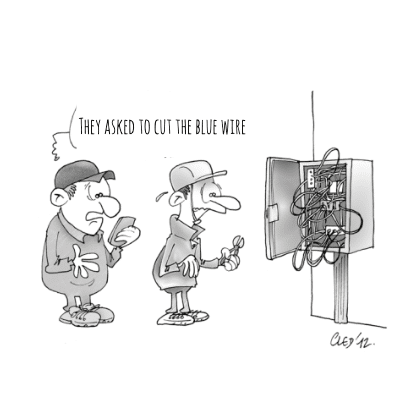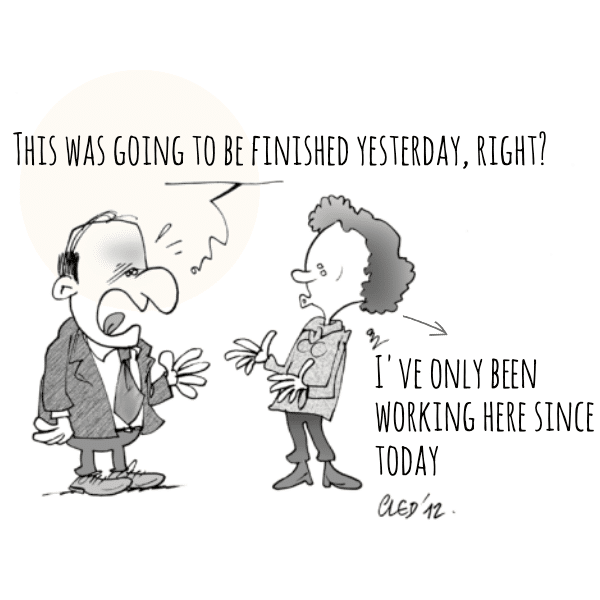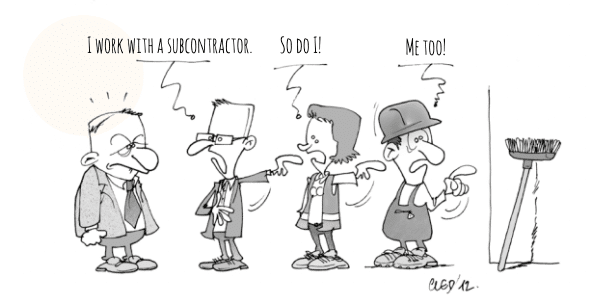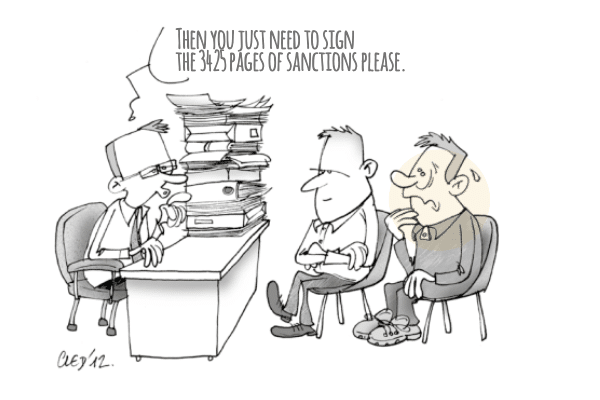INDUSTRIAL OUTSOURCING
Reduce the risks
From an industrial perspective, the benefits of hiring contractors are numerous. Companies can call upon additional and/or specific skills. Hiring contractors can lead to greater flexibility in work organizations and a potential cost reduction. 74% of companies with industrial installations use third parties (source: INSEE). But working with third parties also carries risks. Within your contractor management, strong risk management is essential.
What are the hazards? What are the best practices?

The hazards
Loss of control over installation and activity
Poorly managed subcontracting compromises the contractees’ overview. They miss essential information about the condition of their installations and about the work, performed by third parties. This is because fewer permanent employees are present during the interventions. Less information is collected about the installations and deviations or damage are noticed less quickly. The fragmentation of tasks and responsibilities and the lack of a global vision create major risks.
Where does it go wrong?
During the preparation of the control requirements
Often, the expertise of in-house personnel is not sufficiently focused on the realities of the field and the implementation of the outsourced activities. This is due to a lack of feedback and experience in the field and complicates the determination of risk management requirements (the sources of danger, associated countermeasures, precautions to be taken, etc.).

In controlling and monitoring the outsourced activities
Since employees of the contractees do not perform technical tasks (and techniques are constantly evolving), their ability to assess the quality of the work is often inadequate. This is dangerous during the qualification of a subcontractor and/or the inspection of the work performed.
During contracting
When the outsourcing rate is high, sometimes things go wrong during the preparation of specifications for the job to be performed. This is due to a lack of knowledge of the installations and activities. This often occurs when the drafter of the requirements is located far from the site (e.g. central services ).
Insufficient risk management on the contractor side
The contractor, especially during ad hoc interventions, does not always have a good understanding of the risks associated with the facilities in which or on which he is working. Even emergency restrictions, which are added to minimize production interruptions, sometimes exacerbate the situation. Acknowledgment of risks (especially in complex installations) requires specific support measures and time. Its sustainability is not guaranteed. Finally, a lack of mutual communication between the client and the contractor hinders effective risk management.
A weakening of the process
The limited duration of contracts and changing contractors often leads to a certain instability of the skills deployed and the loss of “memory” of the installation. As a result, powerful cooperative mechanisms are compromised. This problem also arises in the case of long-term contracts, when the contracting firm is faced with high staff turnover.
Risks taken by the contractor
The client is aware of the risks associated with the job and must share them with the contractor. However, the contractor may even create new risks, of which the nature and consequences are sometimes difficult to oversee. This happens even more frequently when the contracting firm is working with subcontractors.

A multitude of activities
Several interventions can take place simultaneously: some are carried out by the external company and others by the operator or by other service providers. This creates new risks such as changes in the working environment, the materials present, the operation of the systems, etc. In addition, the coordination and planning actions become a lot more complex.
Responsibilities of the contractee
The outsourcing of activities should not be accompanied by the outsourcing of risk management. The client may be tempted to think that outsourcing a task is also an exemption from risk management, under the pretext that the contractor has the required qualifications and certifications.
The contractor is automatically considered at fault
If a third party is involved in an incident, the socio-technical context is often overlooked in search of the culprit. But, remember, the contractee remains responsible for defining, applying and implementing the control framework for risk management.
When working with subcontractors
When a job is delegated to a subcontractor, the contractual situation should be the same as that between the contractor and the client. However, this intermediate level can cause difficulties, resulting in responsibilities not being included.

The impact of financial pressures on risk management
Economic pressures, production pressures, optimization of deadlines and costs…, weigh on the attention paid to the preparation, control and delivery of the work, which are sometimes considered “unproductive tasks”. Yet these tasks are crucial.
Subcontractors are hired
This often leads to a loss of organizational flexibility and reduced responsiveness.

A breach of trust
Regular public tenders can lead service providers to decide, in order to protect their interests, not to share certain information with the client. This may include withholding specific know-how, working methods or even concealing difficulties, which occurred during the intervention, for fear of sanctions or not to lose their rating.
The client invests less in risk analysis
Often tasks that are considered less interesting (logistics, waste management, etc.) are outsourced and not always subject to a robust risk analysis. The same is true for additional work that is added at the last minute. The scope of the work may go beyond what was originally planned (“while you’re at it…”). In most cases, these additional works are not subjected to the initial risk analysis and therefore pose an additional risk.
Good practices
Align tenders with needs in the field
Contracts drawn up by central (or national/international) services might contain requirements which are not tailored for a specific site or local situation. This has a detrimental effect on performance and safety. A close and centralized cooperation between the purchasing department, technical departments and departments in charge of risk management can help.
Don’t go for the cheapest one
The financial aspect should come second to quality and safety. In addition to reducing costs, strive for a healthy network of contractors and take into account the viability of these companies.
Contractually define the responsibilities of all actors
Provide a clear division of the checks to be carried out during and after the work. Also clearly define the tasks of preparatory work (tank cleaning, grounding, tank emptying, etc.). Integrate time for self-monitoring or supervision into budgets. This allows the contracting firm to budget for these items. Ensure that subcontractors are also subject to the same requirements.
Provide effective safety training
The training should be designed to meet the risks associated with the work and the context in which the job is performed. Make sure that the training is followed effectively and include a test moment. Impose clear sanctions for ignoring or not taking safety rules seriously.
Provide a watertight qualification
Make sure all qualification requirements are met, both at company and individual level. Take their experience into account and check that they have the necessary authorizations.
Make sufficient time for a thorough risk analysis
Determine the appropriate prevention, protection and mitigation measures and share the analysis with the contractor. Based on this analysis, contact the departments that may be affected by the interventions. Communicate clearly to them the nature and duration of the planned works, so that each service is able to analyze the risks associated with them. Do not settle for an annual generic prevention plan for annual contracts. Ensure that it is updated on a regular basis. Provide contractual mechanisms that assess urgent work before intervention begins.
Invest in a relationship of trust
Creating a climate of trust will facilitate collaboration. Do you want to increase the impact of your risk management? Then shift the focus from sanctions to corrective actions. When clients are listening, analyzing and correcting, they will obtain much more feedback and input from the contractor.
Onyx one

Strong risk prevention ensures that working with contractors is an asset rather than a source of frustration and danger. Onyx One, the industry’s contractor management system, organizes and monitors the collaboration between the contractee and the contractor companies. It is a stable, complete and reliable system, which handles the qualification process, onboarding, and monitoring of contractors and subcontractors. It is intuitive cloud software, containing different modules. Contact us for further information or a demo.
[av_postslider link=’category,129′ wc_prod_visible=” wc_prod_hidden=’hide’ wc_prod_featured=” prod_order_by=” prod_order=” date_filter=” date_filter_start=” date_filter_end=” date_filter_format=’yy/mm/dd’ period_filter_unit_1=’1′ period_filter_unit_2=’year’ items=’9′ offset=’0′ contents=’title’ columns=’3′ preview_mode=’auto’ image_size=’portfolio’ autoplay=’no’ interval=’5′ img_scrset=” lazy_loading=’disabled’ alb_description=” id=” custom_class=” template_class=” av_uid=’av-kz3t4ghr’ sc_version=’1.0′]
Source citation: aria.developpement-durable.gouv.fr